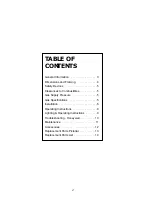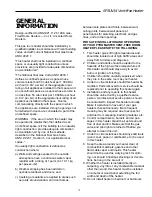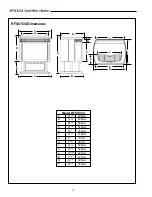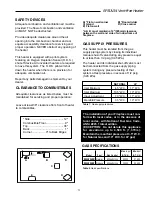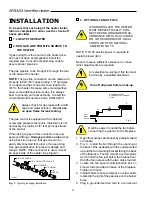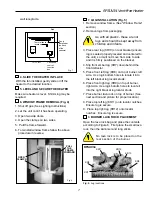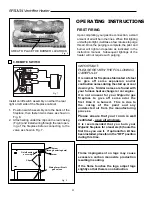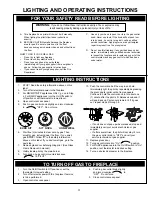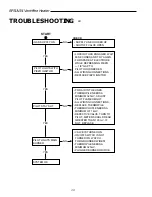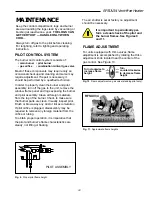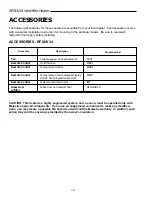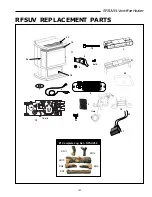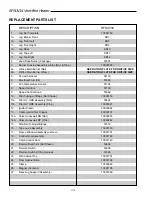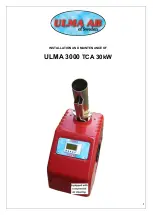
3
RFSUV34 Vent-Free Heater
GENERAL
INFORMATION
FOR SAFE INSTALLATION AND OPERATION
OF YOUR PYROMASTER VENT-FREE ROOM
HEATER PLEASE NOTE THE FOLLOWING:
1. This heater gives off high temperatures and
should be located out of high traffic areas and
away from furniture and draperies.
2. Children and adults should be alerted to the
hazards of the high surface temperatures of
this heater and should stay away to avoid
burns or ignition of clothing.
3. Children should be carefully supervised when
they are in the same room as your heater.
4. Under no circumstances should this heater be
modified. Parts removed for service should be
replaced prior to operating this heater again.
5. Installation and any repairs to this heater
should be carried out by a qualified service
person. A professional service person should
be contacted to inspect this heater annually.
Make it a practice to have all of your gas
heaters checked annually. More frequent
cleaning may be required due to excess lint
and dust from carpeting, bedding material, etc.
6. Control compartments, burners and air pas-
sages in this heater should be kept clean and
free of dust and lint. Make sure that the gas
valve and pilot light are turned off before you
attempt to clean this unit.
7. Under no circumstances should any solid fuels
(wood, coal, paper or cardboard, etc.) be used
in this heater.
8. Keep the area around your heater clear of
combustible materials, gasoline and other
flammable vapor and liquids. This heater
should not be used as a drying rack for cloth-
ing, nor should Christmas stockings or decora-
tions be hung in the area of it.
9. Whether the heater is installed directly on
carpeting, vinyl tile or any combustible material
other than wood, this heater must be installed
on a metal or wood panel extending the full
width and depth of the heater.
10. Do not install heater in bedroom or bathroom.
Design-certified to ANSI Z21.11.2b 1998. Gas-
Fired Room Heaters — Vol. II, Unvented Room
Heaters.
This gas room heater should be installed by a
qualified installer in accordance with local building
codes and with current National Fuel Gas Code.
ANSI Z223.1.
"This heater shall not be installed in a confined
space or unusually tight construction unless
provisions are provided for adequate combustion
and ventilation air".
"The
National Fuel Gas Code, ANSI Z233.1
defines a confined space as a space whose
volume is less than 50 cubic feet per 1,000 Btu
per hour (4.8m
3
per kw) of the aggregate input
rating of all appliances installed in that space and
an unconfined space as a space whose volume is
not less than 50 cubic feet per 1,000 Btu per hour
(4.8 m
3
per kw) of the aggregate input rating of all
appliances installed in that space. Rooms
communicating directly with the space in which
the appliances are installed, through openings not
furnished with doors, are considered a part of the
unconfined space.
WARNING: If the area in which the heater may
be operated is smaller than that defined as an
unconfined space or if the building is of unusually
tight construction, provide adequate combustion
and ventilation air by one of the methods,
described in the National Fuel Gas Code,
ANSI Z 223.1, Section 5.3 or applicable local
codes."
Unusually tight construction is defined as
construction where:
a) Walls and ceilings exposed to the outside
atmosphere have a continuous water vapor
retarder with a rating of 1 perm (6 x 10-11 kg
per pa-sec-m2)
b) Weather stripping has been added on
openable windows and doors, and
c) Caulking or sealants are applied to areas such
as joints around window and door frames,
between sole plates and floors, between wall-
ceiling joints, between wall panels, at
penetrations for plumbing, electrical, and gas
lines, and at other openings.


